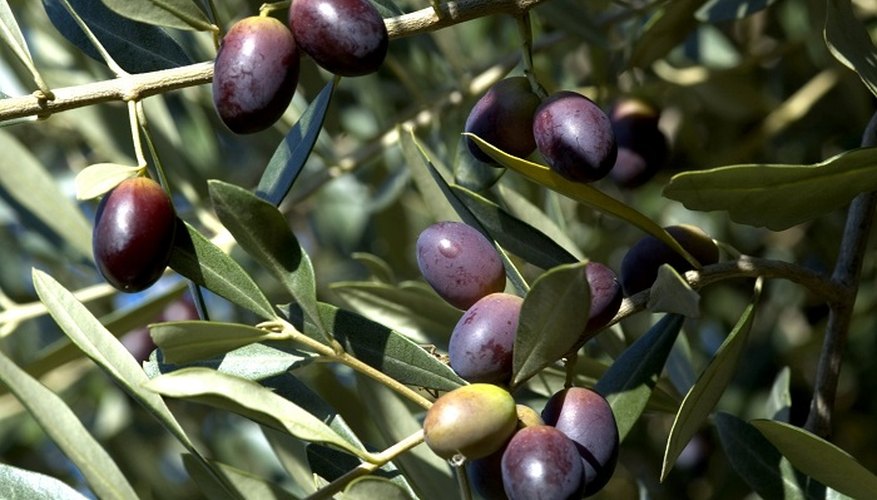The olive tree can live up to 500 years and can survive arid climates and temperatures down to -10 degrees C (14F). Its thick, tough trunk has a sturdy and complex root system that protects it from drought, fire, and gives it the ability to regenerate even if the above-ground structure is destroyed. But even with all these strengths, the olive tree is not invincible. By examining your tree you will be able to tell if it is healthy or not.
Verticillium wilt
Verticillium wilt has many symptoms, which include the sudden wilting of leaves, the sticking of foliage to the branch, inward-curling leaves and dying shoots and branches. Other signs include leaves that lose their green lustre and turn dull grey to brown, scorched leaves, and leaf, fruit and flower drops. Verticillium wilt is a fungus that survives in the soil and roots of a tree and spreads upwards through the trunk. It is passed to other plants through uncleaned tools used on an infected plant and by planting new plants in infected soil. There is no cure for verticillium wilt. When left unchecked it can kill the plant.
- Verticillium wilt has many symptoms, which include the sudden wilting of leaves, the sticking of foliage to the branch, inward-curling leaves and dying shoots and branches.
Olive knot
Olive knot is characterised by creamy whitish rough galls 1.25 to 5 cm (1/2 inch to 2 inches) in diameter that appear on the trunk and branches of a tree. The galls turn black over time and may ooze bacteria. The bacteria usually enter through a cut or opening in the tree and interrupt the water and sugar supply, causing dead branches and falling leaves. Olive knot is difficult to control as it is spread by watering and rain. The bacteria can be transferred to other plants through infected sheers and can kill the tree if the infections occurs on the trunk of a young tree. Remedies are available to maintain and suppress the infection of olive knot.
- Olive knot is characterised by creamy whitish rough galls 1.25 to 5 cm (1/2 inch to 2 inches) in diameter that appear on the trunk and branches of a tree.
- The bacteria usually enter through a cut or opening in the tree and interrupt the water and sugar supply, causing dead branches and falling leaves.
Fruit mummification
Fruit mummification is apparent when brown lesions appear on the olive fruit and expand. They eventually take over the entire fruit skin leaving behind only a shrivelled brown mummy of the olive. Fruit mummification is the result of the fungus Gleosporium olivarum. It starts at the distal end of the olive fruit and is helped along by the presence of water. The combination of watering and humidity causes the infection to spread, leads to fruit drop and an increase in acidity in the extracted olive oil. Fruit mummification is more common in Portugal, Greece and Lebanon and it can be prevented by using fungicide before the rainy season.
- Fruit mummification is apparent when brown lesions appear on the olive fruit and expand.
- Fruit mummification is more common in Portugal, Greece and Lebanon and it can be prevented by using fungicide before the rainy season.
Leaf spot
Leaf spot causes the leaves of the olive tree to turn chlorotic, yellow or whitish in colour. Also the undersides of the leaves become covered in a fungus that resembles black dust covering the surface of the leaf. On a tree with leaf spot the leaves fall and the fruits develop brown lesions and often fall to the ground prematurely. Leaf spot is transferred to other parts of the tree through watering but can be counteracted by pruning and the use of various pesticides.
- Leaf spot causes the leaves of the olive tree to turn chlorotic, yellow or whitish in colour.
- Leaf spot is transferred to other parts of the tree through watering but can be counteracted by pruning and the use of various pesticides.
Pests
Any infestation of pests on the olive tree can be harmful to the tree and its fruit. The olive tree has three main insects that are drawn to it. The fruit fly, the olive moth and the black scale can all cause serious problems for the olive tree. These pests can eat and lay larva in the branches, bark and fruit of a tree causing an infestation. An infested tree can lose fruit, flower and leaves. Treat with pruning and pesticides.
- Any infestation of pests on the olive tree can be harmful to the tree and its fruit.
